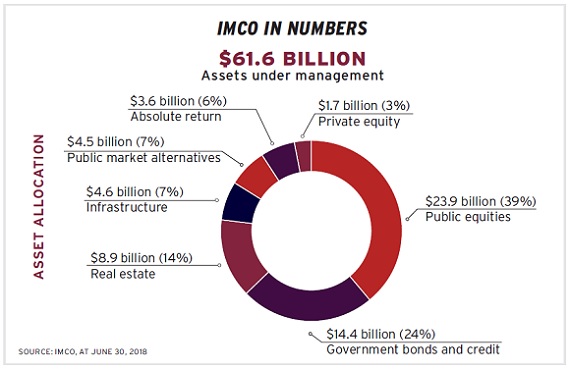

In 2016, when Bert Clark became the Investment Management Corp. of Ontario’s first president and chief executive officer, he was tasked with building the organization from scratch.
Like a startup, he had the opportunity to begin from square one, free of legacy systems. “I think one of the advantages we have is that we’re 25 years behind all of our peers,” he says.
In 2017, IMCO began managing assets of about $60 billion on behalf of the Ontario Pension Board and the Workplace Safety and Insurance Board.
Read: New Ontario investment body hits another milestone
Both organizations came with separate asset mixes and investment strategies, says Clark, noting IMCO’s approach so far has been managing the assets of both organizations as segregated portfolios.
Getting to know: Bert Clark
Job title: President and chief executive officer of IMCO
Joined IMCO: 2016
Previous role: President and CEO of Infrastructure Ontario
What keeps him up at night: That we’re at the late stages of an investment cycle
Outside of the office he can be found: Spending quality time with his family
“And frankly, the reason we decided to do that is you can only do so many things at once and our priority, in the first instance, was to transfer the staff, the investment management responsibilities and launch IMCO.”
IMCO is now working with both organizations and providing asset mix advice. However, both organizations will retain the right to set their own asset mix. “It’s entirely conceivable that different clients with different liabilities will have different asset mixes, as they probably well ought to,” says Clark.
IMCO has developed numerous investment products, which can be used like building blocks that any organization investing with IMCO can assemble in different combinations to meet their particular risk appetite and return objectives. These include equities/growth-related strategies, inflation-linked strategies, rates-related strategies, highly-liquid strategies and absolute return strategies.
Read: IMCO makes first deal with investment in hardware provider
“Our view is that the future is very hard to predict,” says Clark, citing a number of macro factors that drive overall risk and returns, including equity markets, credit spreads, inflation, interest rates and foreign exchange.
“Once you accept that you can’t predict the future — no one has a crystal ball — then really what you should be trying to do is construct a portfolio that generates the best risk-adjusted returns, irrespective of what happens in those things.”

IMCO is working with the OPB and the WSIB to construct diversified portfolios from a factor-perspective, he says.
IMCO is now entering phase two of its operations, adds Clark. “We have two segregated portfolios, two different asset mixes — legacy asset mixes — and different investment strategies for each of the asset classes. A year and a half from now, or in 2020, we will have worked with both of the clients to enter into new asset mixes . . . and we will have harmonized the investment strategies for them and we will have pooled assets into common products.”
A central role for risk management
IMCO’s chief risk officer reports directly into Clark as a standalone function and plays a role in every investment decision. The investment committee is co-chaired by the chief risk officer and the chief investment officer, says Clark. The risk team also plays a role in helping model portfolios and IMCO has invested in a risk system to monitor portfolio risk in real time. “Ultimately, investment is about taking risk and being paid for risk, and you’re a better investor if you have a better handle on your risk.”
